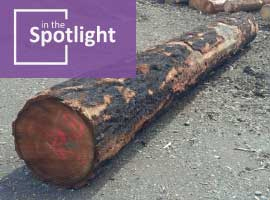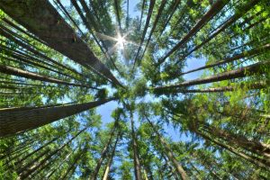With almost 362 million hectares of forest, Canada accounts for 9% of the world’s forests. Each year over the last 25 years, about 7,300 forest fires have occurred, representing an average of about 2.5 million hectares burnt annually.
 Harvesting timber from burned forests raises various environmental, economic, and social issues, particularly from the perspective of forestry activities. Consequently, many government agencies are taking measures to ensure trees are harvested from forests and fibre is recovered from burnt trees after a wildfire. But what does that represent for sawmills particularly as the proportion of burnt wood is increasing?
Harvesting timber from burned forests raises various environmental, economic, and social issues, particularly from the perspective of forestry activities. Consequently, many government agencies are taking measures to ensure trees are harvested from forests and fibre is recovered from burnt trees after a wildfire. But what does that represent for sawmills particularly as the proportion of burnt wood is increasing?
Sawmilling burnt wood: A difficult task
Processing logs from burnt forests can be a challenge for many sawmills, considering the additional work and issues involved; however, there can still be valuable timber under the burnt bark, so the goal is to extract as much as possible of it.
The most obvious challenge to cutting burnt logs is the black carbon on the logs. Being fine by nature, this can clog engine filters, irritates eyes and respiratory tracts, and because it is conductive, it can cause electrical equipment issues.
The good news is that sawmills already have dust collection systems to deal with sawdust in the air, which also greatly reduces the amount of carbon dust within the mill. However, carbon dust in the log storage yard can cause problems for log-handling machines and people.
Working with variable moisture contents
While carbon dust is a problem, the properties of the tree, specifically its moisture content, is affected if the fire has killed the tree. A live “green” tree retains its moisture, but it will begin to lose moisture soon after dying. In addition, the change in moisture content can vary from log to log depending on the degree of fire damage and time since its death. The reduction in moisture content effects sawmill operations in three ways:
- Logs come to the mill yard with the bark still on, which may be unaffected by the fire, may be singed, or may be deeply burnt. As the logs enter the sawmill, debarkers mechanically scrape off the bark, but the degree of burning and loss of moisture content affects the effectiveness of debarking.
- As the log loses moisture, it shrinks, causing cracks to form that would be seen in the boards. In some cases, the crack can be so large that the board breaks.
- If the moisture content varies from log to log, the mill might face difficulties correctly drying the lumber: some boards will be too wet, while others will be dried too much, resulting in cracks that reduce the value of the lumber.
Additional acute complications of fire are that it may increase the likelihood of insects will find home in the trees and cause further damage. Also, depending on the species, decay starts soon after the tree dies.
Burnt wood has always been a proportion of the wood basket so many mills are proficient at handling and processing this fibre. They have added sorting and adjusted machinery working to reduce the impact of processing burnt wood. The challenge is that its proportion is increasing so the mitigation measures that once worked are struggling. The good news is that the sawmill sector has a history of being resilient.
Starting a new cycle
 Natural disturbances such as forest fires, insect, and disease outbreaks, drought, wind throw and floods have occurred in Canada’s forests for thousands of years. Disturbance is part of the natural life cycle of the forest and most often helps the forest to renew itself.
Natural disturbances such as forest fires, insect, and disease outbreaks, drought, wind throw and floods have occurred in Canada’s forests for thousands of years. Disturbance is part of the natural life cycle of the forest and most often helps the forest to renew itself.
Wildfire can be a natural and essential process supporting the long-term health of forested ecosystems. Fire is an essential component of forest renewal releasing nutrients from the soil, opening up tree canopies to increased sunlight, and stimulate dispersal and germination of plant seeds. “Mosaics” or patches of forest that have burned at different times contribute to healthy forest ecosystems, overall forest resilience, and can create natural firebreaks limiting the size of areas burned and intensity.
For more information on processing of burnt wood, please contact
Source: FPInnovations
